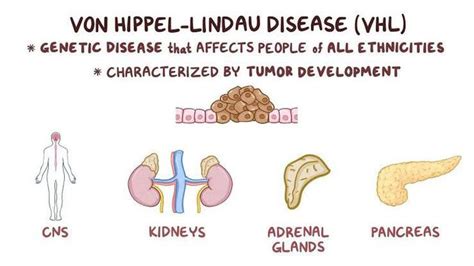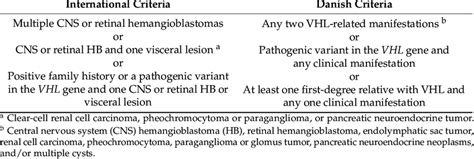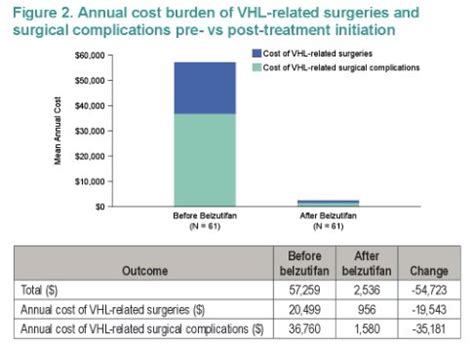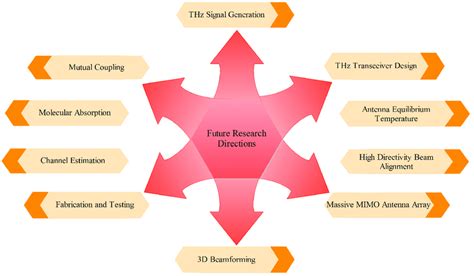Intro
Von Hippel-Lindau syndrome, also known as VHL, is a rare genetic disorder that affects approximately 1 in 36,000 people worldwide. This condition is characterized by the formation of tumors and fluid-filled sacs (cysts) in various parts of the body, including the brain, spine, eyes, kidneys, pancreas, and epididymis. Understanding the symptoms of VHL is crucial for early detection, diagnosis, and treatment, which can significantly improve the quality of life for individuals affected by this condition.
The symptoms of VHL can vary greatly from person to person, depending on the location and size of the tumors and cysts. Some people may experience few or no symptoms, while others may have severe and debilitating symptoms. In general, the symptoms of VHL can be divided into several categories, including neurological, ophthalmological, renal, pancreatic, and epididymal symptoms. Recognizing these symptoms is essential for individuals with a family history of VHL or those who have been diagnosed with the condition.
The importance of understanding VHL symptoms cannot be overstated. Early detection and treatment of VHL-related tumors and cysts can significantly improve outcomes and reduce the risk of complications. For example, removing a tumor from the brain or spine can prevent neurological damage and improve cognitive function. Similarly, treating kidney cancer or pancreatic neuroendocrine tumors can improve survival rates and quality of life. Therefore, it is essential to be aware of the symptoms of VHL and to seek medical attention if any of these symptoms occur.
Von Hippel-Lindau Syndrome Symptoms Overview

The symptoms of VHL can be diverse and may affect various parts of the body. Some common symptoms include headaches, fatigue, weight loss, and vision changes. In addition, individuals with VHL may experience symptoms related to the formation of tumors and cysts in specific organs, such as the brain, eyes, kidneys, pancreas, and epididymis. Understanding these symptoms is crucial for early detection and treatment, which can improve outcomes and reduce the risk of complications.
Neurological Symptoms
Neurological symptoms are common in individuals with VHL and can be caused by the formation of tumors and cysts in the brain and spine. These symptoms may include headaches, fatigue, weakness, numbness, tingling, and difficulty with coordination and balance. In some cases, individuals with VHL may experience seizures, hydrocephalus (fluid accumulation in the brain), or spinal cord compression. Recognizing these symptoms is essential for early detection and treatment, which can improve cognitive function and reduce the risk of neurological damage.VHL-Related Tumors and Cysts

VHL-related tumors and cysts can form in various parts of the body, including the brain, eyes, kidneys, pancreas, and epididymis. These tumors and cysts can cause a range of symptoms, from mild to severe, depending on their location and size. For example, a tumor in the brain may cause headaches, seizures, or difficulty with coordination and balance, while a cyst in the kidney may cause abdominal pain, hematuria (blood in the urine), or kidney failure. Understanding the types of tumors and cysts that can occur in VHL is essential for early detection and treatment.
Ophthalmological Symptoms
Ophthalmological symptoms are common in individuals with VHL and can be caused by the formation of tumors and cysts in the eyes. These symptoms may include vision changes, such as blurred vision, double vision, or loss of vision. In some cases, individuals with VHL may experience retinal detachment, retinal hemorrhage, or cataracts. Recognizing these symptoms is essential for early detection and treatment, which can improve vision and reduce the risk of blindness.VHL Diagnosis and Treatment

Diagnosing VHL typically involves a combination of genetic testing, imaging studies, and physical examination. Genetic testing can identify mutations in the VHL gene, which is responsible for the condition. Imaging studies, such as MRI or CT scans, can detect tumors and cysts in various parts of the body. Physical examination and medical history can also provide important clues for diagnosis. Treatment for VHL depends on the location and size of the tumors and cysts, as well as the individual's overall health. Surgery, radiation therapy, and chemotherapy may be used to treat VHL-related tumors and cysts.
Risk Factors and Prevention
Individuals with a family history of VHL are at increased risk of developing the condition. Genetic testing can identify mutations in the VHL gene, which can help predict the risk of developing VHL. Regular screening and monitoring can also help detect tumors and cysts early, when they are more treatable. Preventive measures, such as avoiding smoking and maintaining a healthy lifestyle, may also reduce the risk of complications.VHL-Related Complications

VHL can cause a range of complications, from mild to severe, depending on the location and size of the tumors and cysts. These complications may include neurological damage, vision loss, kidney failure, pancreatic insufficiency, and epididymal dysfunction. Recognizing these complications is essential for early detection and treatment, which can improve outcomes and reduce the risk of long-term damage.
Living with VHL
Living with VHL can be challenging, both physically and emotionally. Individuals with VHL may experience anxiety, depression, and stress related to their condition. However, with proper treatment and support, many individuals with VHL can lead active and fulfilling lives. Regular screening and monitoring can help detect tumors and cysts early, when they are more treatable. Support groups and counseling can also provide emotional support and help individuals cope with the challenges of living with VHL.VHL Research and Future Directions

Research into VHL is ongoing, with scientists exploring new treatments and therapies for the condition. Advances in genetic testing and imaging studies have improved diagnosis and treatment of VHL. Future directions for research may include the development of targeted therapies, such as gene therapy or immunotherapy, which can selectively target VHL-related tumors and cysts.
Conclusion and Next Steps
In conclusion, VHL is a complex and multifaceted condition that requires careful diagnosis, treatment, and management. Understanding the symptoms of VHL is essential for early detection and treatment, which can improve outcomes and reduce the risk of complications. By recognizing the importance of VHL symptoms and seeking medical attention if any of these symptoms occur, individuals can take the first step towards managing their condition and improving their quality of life.What are the common symptoms of Von Hippel-Lindau syndrome?
+The common symptoms of Von Hippel-Lindau syndrome include headaches, fatigue, weight loss, vision changes, and abdominal pain. Individuals with VHL may also experience symptoms related to the formation of tumors and cysts in specific organs, such as the brain, eyes, kidneys, pancreas, and epididymis.
How is Von Hippel-Lindau syndrome diagnosed?
+Von Hippel-Lindau syndrome is typically diagnosed through a combination of genetic testing, imaging studies, and physical examination. Genetic testing can identify mutations in the VHL gene, which is responsible for the condition. Imaging studies, such as MRI or CT scans, can detect tumors and cysts in various parts of the body.
What are the treatment options for Von Hippel-Lindau syndrome?
+Treatment for Von Hippel-Lindau syndrome depends on the location and size of the tumors and cysts, as well as the individual's overall health. Surgery, radiation therapy, and chemotherapy may be used to treat VHL-related tumors and cysts. Regular screening and monitoring can also help detect tumors and cysts early, when they are more treatable.
Can Von Hippel-Lindau syndrome be prevented?
+While there is no cure for Von Hippel-Lindau syndrome, regular screening and monitoring can help detect tumors and cysts early, when they are more treatable. Genetic testing can also identify mutations in the VHL gene, which can help predict the risk of developing VHL. Preventive measures, such as avoiding smoking and maintaining a healthy lifestyle, may also reduce the risk of complications.
What is the prognosis for individuals with Von Hippel-Lindau syndrome?
+The prognosis for individuals with Von Hippel-Lindau syndrome varies depending on the location and size of the tumors and cysts, as well as the individual's overall health. With proper treatment and management, many individuals with VHL can lead active and fulfilling lives. However, the condition can also cause significant morbidity and mortality if left untreated or undertreated.
We hope this article has provided you with a comprehensive understanding of Von Hippel-Lindau syndrome symptoms, diagnosis, treatment, and management. If you have any further questions or concerns, please do not hesitate to comment below or share this article with others who may be interested. Together, we can raise awareness and promote education about this important topic.
